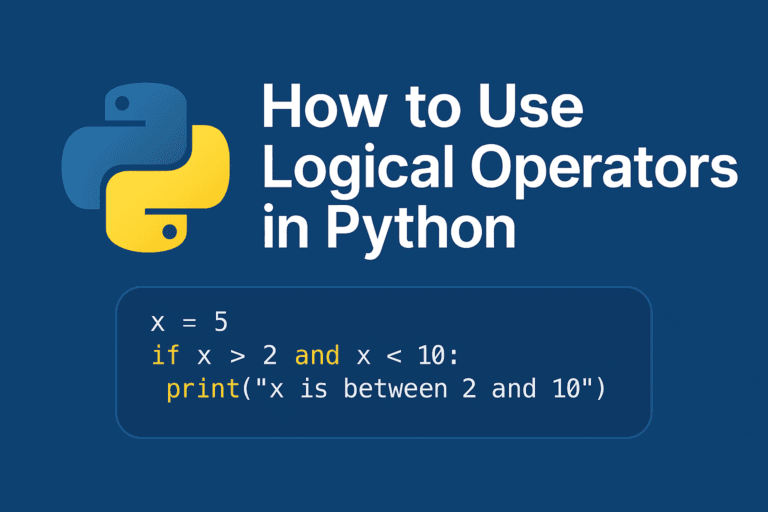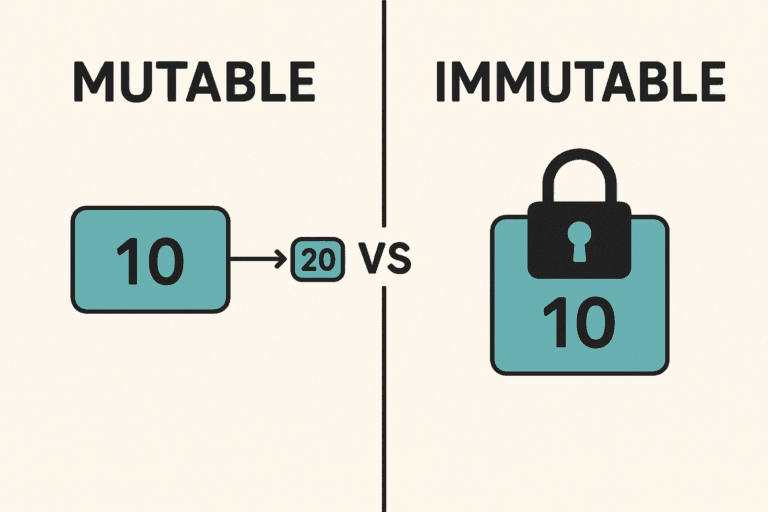How to Write a Python Program for Geometric Progression Step-by-Step
Introduction
So, you’ve heard about Geometric Progression (GP) and now you’re curious how to write a Python program for it? Great—you’re in the right place.
A geometric progression is just a sequence where each number is multiplied by the same value to get the next one. For example:
2, 4, 8, 16, 32…
Here, we’re multiplying by 2 each time.
Now instead of calculating each number by hand, wouldn’t it be easier to write a Python program that does it for you? That’s exactly what we’ll do—step by step.
We’ll start by understanding how a GP works, then write a simple Python program to find any term you want—or even generate the whole sequence. No complicated stuff—just clear, beginner-friendly code.
Let’s get started.
What is a Geometric Progression?

Before we jump into the code, let’s quickly understand what a geometric progression (GP) really is.
It’s just a sequence of numbers where each term is multiplied by the same value—called the common ratio—to get the next one.
Here’s the general form of a geometric progression:
a, ar, ar², ar³, …, arⁿ⁻¹
Where:
- a is the first term,
- r is the common ratio,
- n is the number of terms you want in the sequence.
Let’s make that even clearer with a simple example.
If a = 3 and r = 2, then the sequence would be:
3, 6, 12, 24, 48
We’re just multiplying by 2 each time.
Now that you’ve got the idea, let’s turn this into a Python program—step by step.
Break Down the Problem
Now that we understand what a geometric progression is, let’s think about how we can turn this into a Python program.
To generate a geometric progression, we’ll need the following inputs from the user:
- First term (a) – This is the starting number of the sequence.
- Common ratio (r) – This is the value we multiply each term by to get the next term.
- Number of terms (n) – This is how many terms in the sequence we want to generate.
Once we have those inputs, we’ll use a loop to generate each term of the sequence. A loop will help us calculate each term based on the previous one—starting from the first term and multiplying by the common ratio.
To make it easier, we’ll use the following approach:
- Start with the first term.
- Multiply it by the common ratio to get the next term.
- Repeat this process until we reach the desired number of terms.
Now, let’s put this into code!
Write the Python Code to Calculate geometric progression
Now that we understand the logic behind geometric progression, let’s put it into code. Don’t worry—I’ll explain each step along the way!

Step 1: Get User Input
First, we need to ask the user for three things:
- The first term (a)
- The common ratio (r)
- The number of terms (n)
In Python, we can use the input() function to get these values. Since input() always returns a string, we’ll need to convert those values into the correct data type—float for the first term and the common ratio, and int for the number of terms.
Here’s the code for Step 1:
a = float(input("Enter the first term: "))
r = float(input("Enter the common ratio: "))
n = int(input("Enter the number of terms: "))
a = float(input(...)): This line gets the first term from the user and converts it to a float.r = float(input(...)): This gets the common ratio and converts it to a float.n = int(input(...)): This gets the number of terms and converts it to an integer.
Step 2: Generate the Geometric Progression
Now comes the fun part: using a loop to generate the sequence! We’re going to multiply the first term by the common ratio repeatedly to get the next terms in the sequence.
We’ll use a for loop to do this. The loop will run for the number of terms the user wants, and in each loop, we’ll calculate the next term by multiplying the first term by the common ratio raised to the power of the loop index.
Here’s the code for Step 2:
print("The geometric progression is:")
for i in range(n):
term = a * (r ** i)
print(term, end=" ")
for i in range(n):: This loop will run n times, where n is the number of terms the user entered.term = a * (r ** i): In each iteration, we calculate the i-th term of the progression. We multiply the first term by the common ratio raised to the power of i (which is the index of the current term).print(term, end=" "): This prints each term on the same line, separated by spaces.
Step 3: Example Output
Let’s see how this works with an example. If you enter the following values:
- First term (a) = 2
- Common ratio (r) = 3
- Number of terms (n) = 5
The output will look like this:
Enter the first term: 2
Enter the common ratio: 3
and Enter the number of terms: 5
The geometric progression is:
2.0 6.0 18.0 54.0 162.0
The program generates each term by multiplying the previous one by the common ratio (3), starting with the first term (2). You can see that the sequence is 2, 6, 18, 54, 162.
Explanation of the Code for Beginners

Here’s the full code we wrote earlier:
a = float(input("Enter the first term: "))
r = float(input("Enter the common ratio: "))
n = int(input("Enter the number of terms: "))
print("The geometric progression is:")
for i in range(n):
term = a * (r ** i)
print(term, end=" ")
Let’s go through each part and explain it clearly.
Why float is used
a = float(input("Enter the first term: "))
r = float(input("Enter the common ratio: "))
input(): This function asks the user to type something into the console (like entering a number). But, it always returns that input as a string.- For example, if you type 2, it’s returned as
"2"(a string, not a number).
- For example, if you type 2, it’s returned as
float(): Since the first term (a) and common ratio (r) could be decimal numbers (like 2.5, 3.5, etc.), we usefloat()to convert that string into a number with decimals.- If the user types 2,
float()will convert it into 2.0, which is a float.
- If the user types 2,
This is important because we need to work with numbers, not strings, to do math.
int(input(…))
n = int(input("Enter the number of terms: "))
input()here gets the number of terms the user wants.int()is used to convert that input into an integer (whole number). This is important because the number of terms in a sequence should always be a whole number (you can’t have a fraction of a term).
For example:
- If the user types 5,
int()makes sure it’s treated as 5 (an integer).
What range(n) does
for i in range(n):
range(n): This function generates a sequence of numbers starting from 0 up to n-1. If n = 5,range(5)will give us the numbers 0, 1, 2, 3, 4.- Why do we start at 0? In programming, it’s common to start counting from 0.
for i in range(n):: This sets up a loop that repeats n times. Each time the loop runs, i will be one of those numbers from 0 to n-1.
For example, if n = 5, the loop will run 5 times, with i taking values 0, 1, 2, 3, 4 on each iteration.
How a * (r ** i) calculates each term
term = a * (r ** i)
- Exponentiation (
r ** i): This part is doing the exponentiation or raising to a power. When we writer ** i, we are calculating r raised to the power of i.- If r = 3 and i = 2,
r ** iwould give 3², which is 9.
- If r = 3 and i = 2,
- Multiplying the first term (
a * (r ** i)): Now, we multiply the result by the first term (a).- For example, if a = 2, r = 3, and i = 2, the calculation would be 2 * (3 ** 2) = 2 * 9 = 18.
This is how the program calculates each term in the sequence: it starts with the first term and multiplies by the common ratio raised to the power of the current index (i).
print(term, end=” “)
print(term, end=" ")
print(): This function displays the result on the screen. Here, we are printing the value of term (the current term of the sequence).end=" ": By default,print()will add a new line after each term, which would print each term on a new line. But we don’t want that—we want all the terms to appear on the same line, separated by spaces. So, we useend=" "to tell Python to print each term on the same line, with a space between them.
Recap of How the Code Works:
- User input: The program asks the user to enter the first term, common ratio, and number of terms.
- Loop: The for loop runs for the number of terms (n) and calculates each term using the formula a * r^i.
- Exponentiation:
r ** icalculates the power of the common ratio, so each term increases by multiplying the previous term by r. - Printing the result: The
print()function shows each term on the same line, separated by spaces.
Let’s now modify the program to make it a bit cleaner and add some useful enhancements! We’ll store the terms in a list, calculate the sum of the geometric progression, and use functions to make the code more organized.
Here’s what we’ll cover:
- Storing terms in a list instead of printing each one.
- Finding the sum of the geometric progression.
- Using functions to clean up the code and make it reusable.
Must Read
- Python Optimization Guide: How to Write Faster, Smarter Code
- The Future of Business Intelligence: How AI Is Reshaping Data-Driven Decision Making
- Artificial Intelligence in Robotics
- Rise of Neural Networks: Historical Evolution Practical Understanding and Future Impact on Modern AI Systems
- AI Winter Explained: How Funding Cuts, Failed Promises, and Market Shifts Shaped the Future of Artificial Intelligence
How to Modify the Program

Let’s break it down step-by-step:
1. Storing the terms in a list
Instead of printing each term one by one, we can store all the terms in a list. This will allow us to use the terms later on, if needed, like for calculations (e.g., finding the sum).
You can store the terms using a list comprehension. This is a concise way to create a list in Python.
Here’s how you do it:
gp = [a * (r ** i) for i in range(n)]
print("Geometric progression as a list:", gp)
[a * (r ** i) for i in range(n)]: This is a list comprehension. It creates a list of terms where each term is calculated by a * (r ** i) for each value of i from 0 to n-1.gp: This variable holds the entire list of terms of the geometric progression.
2. Finding the sum of the geometric progression
Once we have the list of terms, we can easily calculate the sum of the geometric progression using Python’s built-in sum() function. Here’s how you can do that:
print("Sum of the series:", sum(gp))
sum(gp): This function adds up all the terms in the listgpand returns the total.
3. Using Functions to Clean Up the Code
To make the code cleaner and more reusable, we can put everything into a function. This way, you can generate the geometric progression and get the sum with just a function call!
Here’s how you can do it:
def generate_gp(a, r, n):
# Generate the geometric progression
gp = [a * (r ** i) for i in range(n)]
return gp
def main():
# Get user input
a = float(input("Enter the first term: "))
r = float(input("Enter the common ratio: "))
n = int(input("Enter the number of terms: "))
# Generate the geometric progression
gp = generate_gp(a, r, n)
# Print the geometric progression and sum
print("Geometric progression as a list:", gp)
print("Sum of the series:", sum(gp))
# Call the main function to run the program
main()
generate_gp(a, r, n): This function generates the geometric progression and returns it as a list. We take the first term (a), common ratio (r), and number of terms (n) as inputs.
main(): This is where we get the user’s input and then call generate_gp() to generate the sequence. Finally, it prints the geometric progression and the sum.
main() is called at the end of the program to run everything.
Full Code with Enhancements
Here’s the complete code with all the changes and enhancements:
def generate_gp(a, r, n):
# Generate the geometric progression
gp = [a * (r ** i) for i in range(n)]
return gp
def main():
# Get user input
a = float(input("Enter the first term: "))
r = float(input("Enter the common ratio: "))
n = int(input("Enter the number of terms: "))
# Generate the geometric progression
gp = generate_gp(a, r, n)
# Print the geometric progression and sum
print("Geometric progression as a list:", gp)
print("Sum of the series:", sum(gp))
# Call the main function to run the program
main()
How It Works:
generate_gp(): This function takes the first term, common ratio, and number of terms as input and returns the geometric progression as a list.main(): This function handles user input, calls thegenerate_gp()function to generate the sequence, and then prints both the progression and its sum.- Output: It shows the list of terms and the sum of the series, making the program cleaner and easier to manage.
Output:
If you enter:
- First term (a) = 2
- Common ratio (r) = 3
- Number of terms (n) = 5
The output will be:
Enter the first term: 2
Enter the common ratio: 3
Enter the number of terms: 5
Geometric progression as a list: [2.0, 6.0, 18.0, 54.0, 162.0]
Sum of the series: 242.0
Recap of Enhancements:
- Storing terms in a list: We used a list comprehension to store the terms instead of printing each one.
- Sum of the series: We used the
sum()function to calculate the sum of the geometric progression. - Using functions: We created functions to organize the code and make it more reusable.
Now, you have a more flexible program that can easily be modified or reused in other projects!
Common Mistakes to Avoid
When writing your Python program for a geometric progression, there are a few common mistakes you should watch out for. Here’s a checklist of things to keep in mind:

1. Using int() Instead of float() and Losing Precision
- Mistake: If you use
int()instead offloat()when getting input for the first term (a) or common ratio (r), you might lose precision. This can cause errors in your calculations if you’re working with decimal values. - Fix: Always use
float()when you expect decimal numbers (e.g., for the common ratio or first term).
Example:
a = float(input("Enter the first term: ")) # Correct
r = float(input("Enter the common ratio: ")) # Correct
2. Using ^ Instead of ** (Exponentiation in Python)
- Mistake: In Python,
^is used for bitwise XOR (exclusive OR), not for exponentiation. If you mistakenly use^, your program won’t raise the powers as expected, leading to incorrect results. - Fix: Always use
**for exponentiation to raise numbers to a power.
Example:
term = a * (r ** i) # Correct exponentiation
3. Forgetting to Cast input() Values
- Mistake: The
input()function in Python always returns a string, so if you try to use the value in mathematical operations without converting it to the appropriate type (e.g.,floatorint), your program will throw an error. - Fix: Always cast your
input()values to the appropriate type before using them in calculations.
Example:
n = int(input("Enter the number of terms: ")) # Correct for integers
Quick Recap:
- Use
float()for decimal inputs (like first term and common ratio). - Use
**for exponentiation, not^. - Always cast input values to the correct type (
float()for decimals,int()for whole numbers).
By avoiding these simple mistakes, your program will run smoothly and give you the correct results every time!
Python offers some efficient and compact ways to calculate geometric progressions, especially with libraries like NumPy. If you’re looking for a shorter and more concise way to calculate geometric progressions, here’s how you can do it:
Using NumPy to Calculate Geometric Progression in Python
NumPy is a popular library for numerical computations in Python. It can significantly simplify your code and improve performance for operations like geometric progressions. Here’s how you can calculate a geometric progression with NumPy:
import numpy as np
# Get user input
a = float(input("Enter the first term: "))
r = float(input("Enter the common ratio: "))
n = int(input("Enter the number of terms: "))
# Generate the geometric progression using NumPy
gp = a * r**np.arange(n)
print("Geometric progression:", gp)
print("Sum of the series:", np.sum(gp))
Key Points:
np.arange(n): This creates an array of integers from 0 ton-1. It is equivalent torange(n)but returns a NumPy array instead of a Python list, which makes operations like exponentiation more efficient.r**np.arange(n): This calculates the common ratio raised to the power of each term index (from 0 ton-1).np.sum(gp): This function calculates the sum of the terms in the geometric progression in a very compact manner.
Example Output:
If you enter:
- First term (a) = 2
- Common ratio (r) = 3
- Number of terms (n) = 5
The output will be:
Enter the first term: 2
Enter the common ratio: 3
Enter the number of terms: 5
Geometric progression: [ 2. 6. 18. 54. 162.]
Sum of the series: 242.0
Advantages:
- Conciseness: Using NumPy allows you to write the code in fewer lines.
- Performance: NumPy is optimized for large datasets, so it can be more efficient for large values of
n.
When to Use:
If you’re working with more complex calculations or large datasets, NumPy is a great choice. However, if you’re just starting with Python or working on simple projects, the basic for loop method is perfectly fine.
Practice Challenge for You
Now that you’ve got the basics down, it’s time to play around with the code a bit. Here are some simple challenges to help you understand geometric progression better and get more comfortable with Python.
Try These Tweaks:
- Use a negative ratio What happens when the common ratio is negative? Try:
a = 3
r = -2
n = 6You’ll get an alternating sequence:3, -6, 12, -24, 48, -96
2. Try r = 1
When the common ratio is 1, what do you expect?
Hint: All terms should be the same because you’re multiplying by 1 every time.
3. Turn your code into a function
Try wrapping your GP logic into a reusable function like this:
def generate_gp(a, r, n):
return [a * (r ** i) for i in range(n)]
print(generate_gp(2, 3, 5)) # Output: [2, 6, 18, 54, 162]
Now you can call this function with any values of a, r, and n.
This is a great way to build confidence, experiment, and understand how small changes in the formula affect the sequence. Once you’re comfortable, try combining this with plots using matplotlib to visualize the progression!
Conclusion
And there you have it! You’ve just learned how to write a Python program to generate a geometric progression, step by step.
We covered:
- What a geometric progression is
- How to take user input and use a loop to build the sequence
- How to store the results in a list, calculate the sum, and even improve the program using functions
- And some common mistakes to watch out for
Plus, you now have a few practice challenges to help lock it all in!
Whether you’re just starting out or brushing up your Python skills, understanding patterns like geometric progressions is a great way to grow more confident in coding.
If you found this helpful and want more beginner-friendly Python tutorials, feel free to visit emitechlogic.com for more guides, projects, and tips!
Ready to take on the next concept? Let’s keep learning—one simple step at a time.
FAQs
All the terms in the sequence will be the same as the first term, since multiplying by 1 doesn’t change the value.
Yes, but using **float()** helps when working with decimals or fractions, especially if precision is important.
r ** i mean in the code? It means raise the common ratio r to the power of i. For example, 2 ** 3 gives 8.
If the common ratio r is not 1, you can use the formula:
sum = a × (1 – rⁿ) / (1 – r)
But in Python, it’s easier to use:
sum(gp)
after storing the sequence in a list.
External Resources
Python range() function – Official Docs
Understand how range() works when generating sequences.
Geometric Progression – Khan Academy
A beginner-friendly explanation of geometric sequences with visual examples.
NumPy arange() and vector operations – NumPy Docs
Dive deeper into using NumPy for numerical sequences like GPs.
Geometric Series Formula – Math is Fun
Covers both finite and infinite geometric series with interactive examples.
These links offer clear explanations and hands-on examples—perfect if you want to go beyond the basics or reinforce what you’ve learned.








Leave a Reply